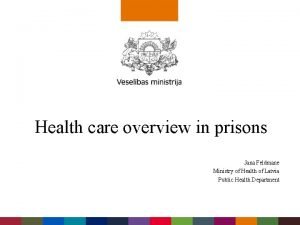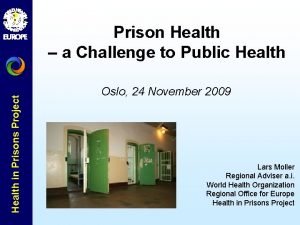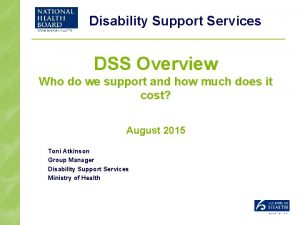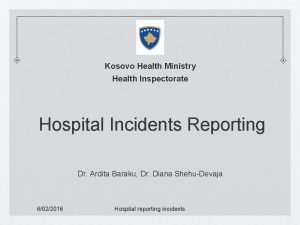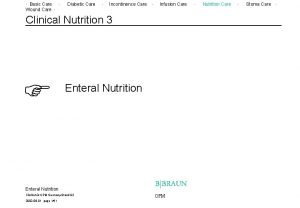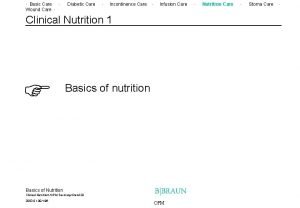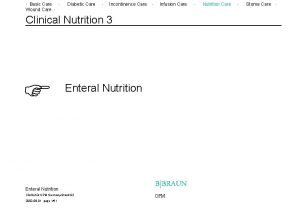Health care overview in prisons Jana Feldmane Ministry














- Slides: 14

Health care overview in prisons Jana Feldmane Ministry of Health of Latvia Public Health Department

General Information 11 prisons total capacity of 6000 persons approximately 4500 inmates yearly 1 correctional institution for juveniles 2 investigation prisons 1 Prison Hospital (with closed department for treatment of active TB) 1 open prison 2 semiclosed prisons 4 closed prisons 1 centre for treatment of addictions (social rehabilitation programmes) is opening on 05. 10. 2016. 2

Legislative framework: Prisons Health System o The Medical Treatment Law - every prisoner has the right to receive the same health care as each citizen of Latvia o Regulation of the Cabinet of Ministers - on how arrested and convicted persons receive health care services - sets framework of health care services for inmates o Regulation of the Cabinet of Ministers - The procedures for organising and financing health care - shared responsibility of both - Ministry of Health and Ministry of Justice 3

Prisons’ Health Care Structure Prison hospital: o with capacity of 200 inmates o well equipped, but provide limited services o lack of specialists o external specialists (psychiatrist, gynaecologist, dentist*) o treatment of active TB Each prison has a medical unit and provides health check upon arrival (medical examination, mandatory screening for TB (chest x-ray), voluntary HIV test) *dentist - prisoners must pay for dental care themselves, with the exception of emergencies 4

HIV o HIV testing is voluntary o In case of clinical symptoms HIV test is recommended o Inmate, who refuses the test, has to certify this by signature o During health check upon arrival approx. 98% of all inmates are being tested o In 2015, 47 new HIV cases were registered in prison settings o Incidence of HIV is 50 times higher as in general population o HIV transmission mainly attributes to injection drug use o The medical doctor in prison hospital has the primary responsibility for HIV infected inmate. The medical treatment of this inmate is shared with the Infectology Centre in Riga 5

HIV in figures Incidence per 100 000 inhabitants/inmates Number of new cases Year 2011 2012 2013 2014 2015 HIV in general population 299 339 340 347 393 14, 4 16, 7 16, 9 17, 4 19, 9 HIV in prison settings 67 59 43 56 47 1004, 4 930, 7 763, 1 1132, 0 1027, 0 6

Hepatitis B and C o Hepatitis B and C tests are only offered to inmates with HIV, clinical symptoms, or upon inmate’s request o In 2015, only 27 new cases of hepatitis C were registered in prison settings o Hepatitis transmission mainly attributes to injection drug use o The medical treatment of hepatitis is shared with the Infectology Centre in Riga o Treatment of hepatitis C as well as interferon-free therapy is covered by health care budget o The barrier for hepatitis C diagnosis and treatment in prisons is that diagnostics of hepatitis takes place outside the prison 7

Hepatitis B and C in figures Hepatitis B Total number of new cases Per 100 000 inhabit. 2007 553 2008 Hepatitis C In prison settings Per 100 000 inmates 2015 Total number of new cases Per 100 000 inhabit. In prison settings Per 100 000 inmates 2015 26, 1 3 45, 5 1680 77, 9 10 151, 7 555 25, 7 2 29, 8 1466 67, 3 5 74, 5 2009 458 21, 4 3 43, 1 1356 63, 6 7 100, 5 2010 316 15, 1 1 14, 5 1112 53, 0 3 43, 4 2011 315 15, 3 0 0, 0 1336 64, 9 7 104, 9 2012 330 16, 2 1 15, 8 1410 69, 3 2 31, 6 2013 329 16, 3 1 17, 7 1274 63, 3 5 88, 7 2014 301 15, 0 1 20, 2 1764 88, 1 27 545, 6 2015 388 19, 6 4 90, 7 1859 93, 9 46 1043, 3 Year 8

Tuberculosis o Mandatory TB screening is provided for all persons entering the prison o 29 new cases of TB are registered in prison settings in 2015 o There are well established DOTS therapy 9

Tuberculosis in figures Year Total number of new cases New cases in prison settings Risk factors Alcohol use Drug use HIV positive 2011 788 43 16 16 16 1012 880 50 28 28 23 1013 776 45 13 19 13 2014 637 44 6 24 20 2015 621 29 11 18 7 10

Treatment of the Addictions o Recent study of CDPC Latvia indicated that 66, 1% of the prison population had ever used drugs, and 31, 8% of inmates reported that they had continued to use of drugs while in prison o Collaboration with Riga Narcology centre in order to ensure treatment of addictions o OST is not initiated in the prison settings but is continued for inmates who used to receive OST before they were admitted o Methadone is not available through the prison pharmacies and is purchased from external providers o Anonymous meetings in prisons o Minnesota and other social rehabilitation programmes will be available at the Olaine prison from 05. 10. 2016. 11

Prisoners' Health Care Records o Health care records are paper-based o Well established data collection system in all prisons, which includes diagnose and care o The health records of prisoners are updated every three months and include information about treatment (OST, ARV, DOTS etc. ) o Central registry - qualification of medical staff 12

Challenges o To improve HIV and hepatitis B and C testing in order to ensure that each inmate knows his status o To improve access to hepatitis C treatment o To ensure sustainability of inmate’s health after release 13

Thank you for your attention 14
 Per jana
Per jana Health in prisons project
Health in prisons project Overview of education in health care
Overview of education in health care Unit 4 criminology
Unit 4 criminology Prison token economy
Prison token economy Folsom prison famous inmates
Folsom prison famous inmates Esol prisons
Esol prisons Primary secondary and tertiary health care
Primary secondary and tertiary health care Unit 2 equality diversity and rights
Unit 2 equality diversity and rights Health and social care component 3
Health and social care component 3 Amanda bleckmann ministry of health
Amanda bleckmann ministry of health Health ministry uk
Health ministry uk Israel ministry of health
Israel ministry of health Estonia health ministry
Estonia health ministry Kosovo health ministry
Kosovo health ministry
